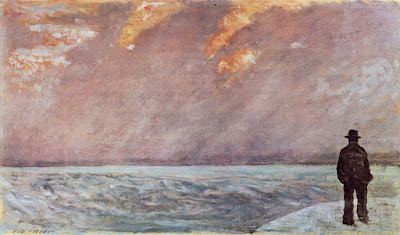The people along the sand
All turn and look one way.
They turn their back on the land.
They look at the sea all day.
As long as it takes to pass
A ship keeps raising its hull;
The wetter ground like glass
Reflects a standing gull
The land may vary more;
But wherever the truth may be-
The water comes ashore,
And the people look at the sea.
They cannot look out far.
They cannot look in deep.
But when was that ever a bar
To any watch they keep?
- A Further Range by Robert Frost, New York, Holt: 1936
Pairing images by the nineteenth century Italian painter Giovanni Fattori with a poem by a twentieth century American poet Robert Frost is not so fanciful as it might at first seem. Italy is a country surrounded on three and a half sides (in length) by water and the Atlantic ocean in Frost's poem was the entry point and the orientation for generations of European settlers. Oddly enough, the sea is a larger presence in French painting and literature than either of the other two. Odd because in France the beaches and fishing ports are like exiles in the outer provinces (Normandy, Brittany, Gasgogne, and Provence) while the capital of both country and culture in is far inland in Paris.
Giovanni Fattori (1825 –1908) was an Italian artist. In middle age Fattori was attracted to the landscapes of the French Barbizon painters; because of their influence he gave up historical subjects for paintings outdoors (en plein-air) and became a convert to painting in natural light. He was one of the founders of the group dubbed the Macchiaioli, painters of the light. One of those was his friend Silvestro Lega; Fattori's painting shows Lega sitting on outcropping of rocks as he paints the waves cresting around him.
Images:
1. Giovanni Fattori - Tramunto sul mare (Sunset on the Shore), c. 1890-95, Galeria d'Arte Moderna + Florence.2. Giovanni Fattori - Silvestro Lega Painting by the Sea, c. 1866, Collection Juncker, milan.





0 Yorumlar